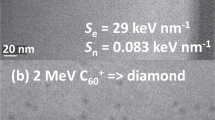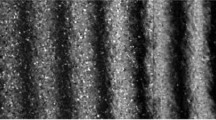Abstract
On its way through a solid, an energetic heavy ion deposits an enormous amount of kinetic energy per unit path length during an extremely short time interval. The energy transfer induces very fast primary processes which can cause, depending on the specific solid properties, damages ranging from point defects to a total amorphization in the case of crystalline material within a long, thin cylinder-shaped volume along the ion trajectory. Details of size, shape, and morphology of the ion tracks, though representing the final stage of the damage creation, store indirect information about the not simultaneously observable very rapid primary processes. We present images and additional information on the properties of ion tracks in germanium monosulfide, highly oriented pyrolytic graphite, and muscovite mica achieved with transmission electron-, scanning tunneling-, and scanning force-microscopy.
Access this chapter
Tax calculation will be finalised at checkout
Purchases are for personal use only
Preview
Unable to display preview. Download preview PDF.
Similar content being viewed by others
References
Ackermann J. (1994): Rasterkraftmikroskopie an Schwerionen-bestrahlten Materialien: Spuruntersuchungen und Entwicklung eines UHV-Kraftmikroskops, Doctoral thesis, University of Heidelberg.
Ackermann J., Angert N., Grafström S., Hagen T., Neitzert M., Neumann R. and Trautmann, C. (1995): Force microscopy of heavy-ion irradiated materials. In: Forces in Scanning Probe Methods (eds. Güntherodt H.-J., Anselmetti D. and Meyer E. ), Kluwer Academic Publishers, Dordrecht, Boston, London, pp. 489–494.
Ackermann J., Angert N., Neumann R., Trautmann C., Dischner M., Hagen T. and Sedlacek M. (1996): Ion track diameters in mica studied with scanning force microscopy. Nucl. Instrum. and Meth. B 107, 181–184.
Ackermann J., Grafström S., Hagen T., Kowalski J., Neumann R. and Sedlacek M. (1997): Scanning force microscopy of latent heavy-ion tracks in ultrahigh vacuum. In: Micro/Nanotribology and its applications (ed. Bhushan B. ), Kluwer Academic Publishers, Dordrecht, Boston, London, pp. 261–267.
Albrecht D., Armbruster P., Spohr R., Roth M., Schaupert K. and Stuhrmann H. (1985): Investigation of heavy ion produced defect structures in insulators by small angle scattering. Appl. Phys. A 37, 37–46.
Albrecht D., Balanzat E., and Schaupert K. (1986): X-ray small angle scattering investigation of high energy Ar-tracks in mica. Nucl. Tracks Radial. Meas. 11, 93–94.
Bonfiglioli G., Ferro A., and Mojoni A. (1961): Electron microscope investigation on the nature of tracks of fission products in mica. J. Appl. Phys. 32, 2499–2503.
Bouffard S., Cousty J., Pennec Y. and Thibaudau F. (1993): STM and AFM observations of latent tracks. Radiat. Eff. Def. Sol. 126, 225–228.
Bursill L.A. and Braunshausen G. (1990): Heavy-ion tracks in zirkon. Phil. Mag. 62, 395–420.
Coratger R., Claverie A., Ajustron F. and Beauvillain J. (1990): Scanning tunneling microscopy of defects induced by carbon bombardment on graphite surfaces. Surf. Sci. 227, 7–14.
Dartyge E. and Lambert M. (1974): Formation de défauts dans les échantillons de mica muscovite irradiés par des ions de grande énergie. Radial. Eff. 21, 71–79.
Dartyge E., Duraud J.P., Langevin Y. and Maurette M. (1981): New model of nuclear particle tracks in dielectric minerals. Phys. Rev. B 23, 5213–5229.
Daya D.D.N.B., Hallén A., Hlkansson P., Sundqvist B.U.R. and Reimann C.T. (1995a): Swift-heavyatomic-ion-induced surface tracks on mica probed by scanning force microscopy. Nucl. Instr. and Meth. B 103, 454–465.
Daya D.D.N.B., Hallén A., Eriksson J., Kopniczky J., Papaléo R., Reimann C.T., Brunelle A., Della-Negra S. and Le Beyec Y. (1995b): Radiation damage features on mica and 1-valine probed by scanning force microscopy. Nucl. Instr. and Meth. B 106, 38–42.
Daya D.D.N.B., Reimann C.T., Hallén A., Sundqvist B.U.R. and Hâkansson P. (1996): Latent (sub-surface) tracks in mica studied by tapping mode scanning force microscopy. Nucl. Instr. and Meth. B 111, 87–90.
Erlandsson R., Hadziioannou G., Mate C.M., McClelland G.M. and Chiang S. (1988): Atomic scale friction between the muscovite mica cleavage plane and a tungsten tip. J. Chem. Phys. 89, 5190–5193.
Fleischer R.L., Price P.B. and Walker R.M. (1975): Nuclear tracks in solids. University of California Press, Berkeley.
Fuchs G., Studer F., Balanzat E., Groult D., Toulemonde M. and Jousset J.C. (1987): Influence of the electronic stopping power on the damage rate of yttrium-iron garnets irradiated by high-energy heavy ions. Europhys. Lett. 3, 321–326.
Grandke T. and Ley L. (1977): Angular-resolved uv photoemission and the band structure of GeS. Phys. Rev. B 16, 832–842.
Grafström S., Neitzert M., Hagen T., Ackermann J., Neumann R., Probst O. and Wörtge M. (1993): The role of topography and friction for the image contrast in lateral force microscopy. Nanotechnology 4 143151.
Grafström S., Ackermann J., Hagen T., Neumann R. and Probst O. (1994): Analysis of lateral force effects on the topography in scanning force microscopy. J. Vac. Sci. Technol. B 12, 1559–1564.
Hagen T., Grafström S., Ackermann J., Neumann R., Trautmann C., Vetter J. and Angert N. (1994): Friction force microscopy of heavy-ion irradiated mica. J. Vac. Sci. Technol. B 12, 1555–1558.
Heuberger M., Dietler G. and Schlapbach L. (1994): Mapping the local Young’s modulus by analysis of the elastic deformations occurring in atomic force microscopy. Nanotechnology 5, 12–23.
Houpert C., Hervieu M., Groult D., Studer F. and Toulemonde M. (1988): HREM investigation of GeV heavy ion latent tracks in ferrites. Nucl. Instr. Meth. B 32, 393–396.
Houpert C., Studer F., Groult D. and Toulemonde M. (1989): Transition from localized defects to continuous latent tracks in magnetic insulators irradiated by high energy heavy ions: A HREM investigation. Nucl. Instr. Meth. B 39, 720–723.
Howald L., Meyer E., Lüthi R., Haefke H., Overney R., Rudin H. and Güntherodt, H.-J. (1993): Multifunctional probe microscope for facile operation in ultrahigh vacuum. Appl. Phys. Lett. 63, 117–119. Katz R. (1978):Track structure theory in radiobiology and in radiation detection. Nuclear Track Detection 2, 1–28.
Kemmer H., Grafström S., Neitzert M., Wörtge M., Neumann R., Trautmann C., Vetter J. and Angert N. (1992): Scanning tunneling microscopy of surface modifications induced by UNILAC heavy-ion irradiation. Ultramicroscopy 42–44, 1345–1349.
Ldznicka M. (1978): Investigation of GeS (001). Czech. J. Phys. B 28, 1031–1035.
Maivald P., Butt H.-J., Gould S.A.C., Prater C.B., Drake B., Gurley J.A., Elings V.B. and Hansma P.K. (1991): Using force modulation to image surface elasticities with the atomic force microscope. Nanotechnology 2, 103–106.
Marti O., Colchero J. and Mlynek J. (1990): Combined scanning and friction force microscopy of mica. Nanotechnology 1, 141–144.
Meftah A., Brisard F., Costantini J.M., Dooryhee E., Hage-Ali M., Hervieu M., Stoquert J.P., Studer F. and Toulemonde M. (1994): Track formation in Si02 quartz and the thermal-spike mechanism. Phys. Rev. B 49, 12457–12463.
Mizes H.A. and Foster J.S. (1989): Long-range electronic perturbations caused by defects using scanneling tunneling microscopy. Science 244, 559–562.
Neumann R., Ackermann J., Angert N., Trautmann C., Dischner M., Hagen, T. and Sedlacek M. (1996): Ion tracks in mica studied with scanning force microscopy using force modulation. Nucl. Instr. and Meth. B 116, 492–495.
Overney R.M., Takano H. and Fujihira M. (1994): Elastic compliances measured by atomic force microscopy. Europhys. Lett. 26, 443–447.
Porte L., Phaner M., De Villeneuve C.H., Moncoffre N.J. and Tousset J. (1989): Scanning tunneling microscopy study of single-ion impacts on graphite surface. Nucl. Instr. Meth. B 44, 116–119.
Porte L., De Villeneuve C.H. and Phaner M. (1991): Scanning tunneling microscopy observation of local damages induced on graphite surface by ion implantation. J. Vac. Sci. Technol. B 9, 1064–1067.
Price P.B. and Walker R.M. (1962): Observation of charged particle tracks in solids. J. Appl. Phys. 33, 3400–3406.
Probst O., Ackermann J., Grafström S., Kowalski J., Neumann R., Neitzert M. and Wörtge M. (1993): Superstructures in the vicinity of heavy-ion induced defects observed by scanning tunneling microscopy. GSI Scientific Report 1992, p. 304.
Radmacher M., Tillmann R.W., Fritz M. and Gaub H. E. (1992): From molecules to cells: Imaging samples with the atomic force microscope. Science 257, 1900–1905.
Sedlacek M. (1995): Rasterkraftmikroskopie an Schwerionenspuren unter Umgebungs-und Ultrahochvakuum-Bedingungen. Diploma thesis, University of Heidelberg.
Schönherr E. and Stetter W. (1975): Growth of germanium monosulfide single crystals by sublimation. J. Crystal Growth 30, 96–98.
Scholz R., Vetter J. and Hopfe S. (1993): Observation of latent heavy-ion tracks in GeS by transmission electron microscopy. Radiat. Eff. Def. Sol. 126, 275–278.
Sharp T.G., Oden P.I. and Buseck P.R. (1993): Lattice-scale imaging of mica and clay (001) surfaces by atomic force microscopy using net attractive forces. Surf. Sci. Lett. 284, L405 - L410.
Silk E.C.H. and Barnes R.S. (1959): Examination of fission fragment tracks with an electron microscope. Phil. Mag. 4, 970–972.
Stanchev A. and Vodenicharov C. (1975): Dielectric properties of thin germanium monosulfide films. Thin Solid Films 29, L13 - L16.
Studer F., Houpert C., Groult D. and Toulemonde M. (1989): Latent tracks in magnetic insulators. Radiat. Eff. Def. Sol. 110, 55–59.
Thibaudau F., Cousty J., Balanzat E. and Bouffard S. (1991): Atomic-force-microscopy observations of tracks induced by swift Kr-ions in mica. Phys. Rev. Lett. 67, 1582–1585.
Toulemonde M., Dufour C. and Paumier E. (1992): Transient thermal process after a high-energy heavy-ion irradiation of amorphous metals and semiconductors. Phys. Rev. B 46, 14362–14369.
Vetter J., Scholz R. and Hopfe S. (1992): Transmission electron microscope observation of heavy-ion tracks in germanium sulfide. GSI Scientific Report 1991, p. 248.
Vetter J. and Scholz R. (1993): High resolution image of a single ion track. GSI Scientific Report 1992, p. 283.
Vetter J., Angert N. and Scholz R. (1994): Latent track dimensions of various ions. GSI Scientific Report 1993, p. 189.
Wiesner J. Træholt C., Wen J.-G., Zandbergen H.-W. Wirth G. and Fuess H. (1996): High resolution electron microscopy of heavy-ion induced defects in superconducting Bi-2212 thin films in relation to their effect on Jc. Physica C 268 161–172.
Wörtge M., Dey S., Grafström S., Hagen T., Kowalski J., Neumann R. and Probst O. (1994): An ultrahigh-vacuum system for STM studies. Rev. Sci. Instr. 65, 2523–2526.
Yan J., Li Z., Bai C., Yang W.S., Wang Y., Zhao W., Kang Y., Yu F.C., Zhai P. and Tang X. (1994): Scanning tunneling microscopy investigations of graphite surface damage induced by gold-ion bombardment. J. Appl. Phys. 75, 1390–1395.
Yan Y., Doyle R.A., Campbell A.M., Wirth G. and Stobbs W.M. (1996): Modulated structure and local oxygen reordering induced by high-energy Au-ion irradiation in YBa2Cu3O7.d. Phil. Mag. Lett. 73, 299–308.
Ziegler J.F., Biersack J.P and Littmark U. (1985): The Stopping and Ranges of Ions in Solids. Pergamon Press, New York.
Author information
Authors and Affiliations
Editor information
Editors and Affiliations
Rights and permissions
Copyright information
© 1998 Springer Science+Business Media Dordrecht
About this chapter
Cite this chapter
Vetter, J., Ackermann, J., Neumann, R., Nistor, L., Scholz, R. (1998). High-Resolution Microscopy of Latent Tracks Induced by High-Energy Heavy Ions. In: van den Haute, P., de Corte, F. (eds) Advances in Fission-Track Geochronology. Solid Earth Sciences Library, vol 10. Springer, Dordrecht. https://doi.org/10.1007/978-94-015-9133-1_1
Download citation
DOI: https://doi.org/10.1007/978-94-015-9133-1_1
Publisher Name: Springer, Dordrecht
Print ISBN: 978-90-481-4977-3
Online ISBN: 978-94-015-9133-1
eBook Packages: Springer Book Archive




